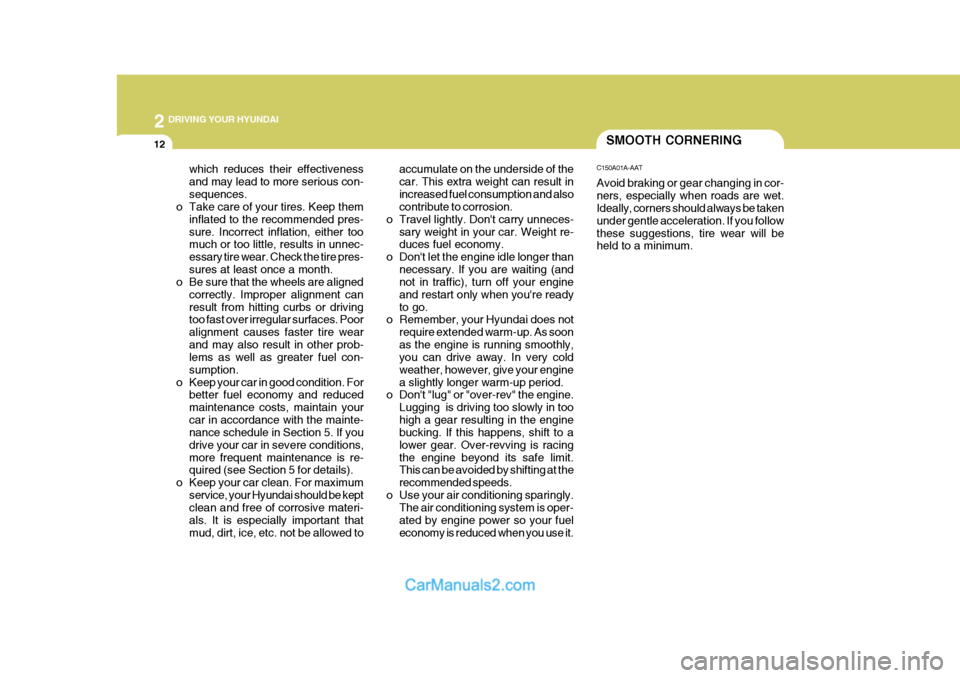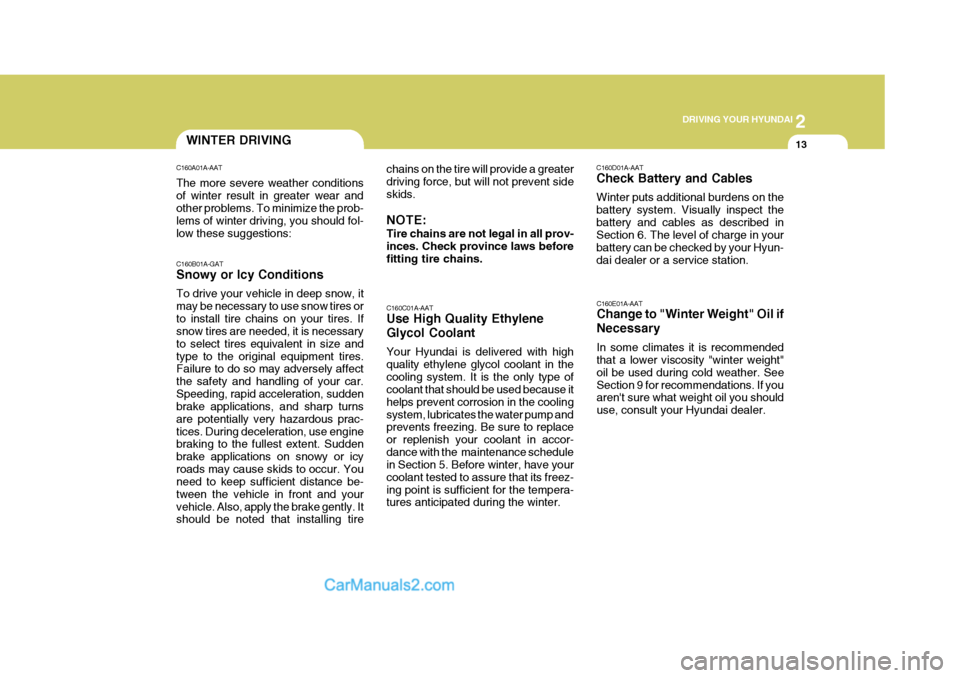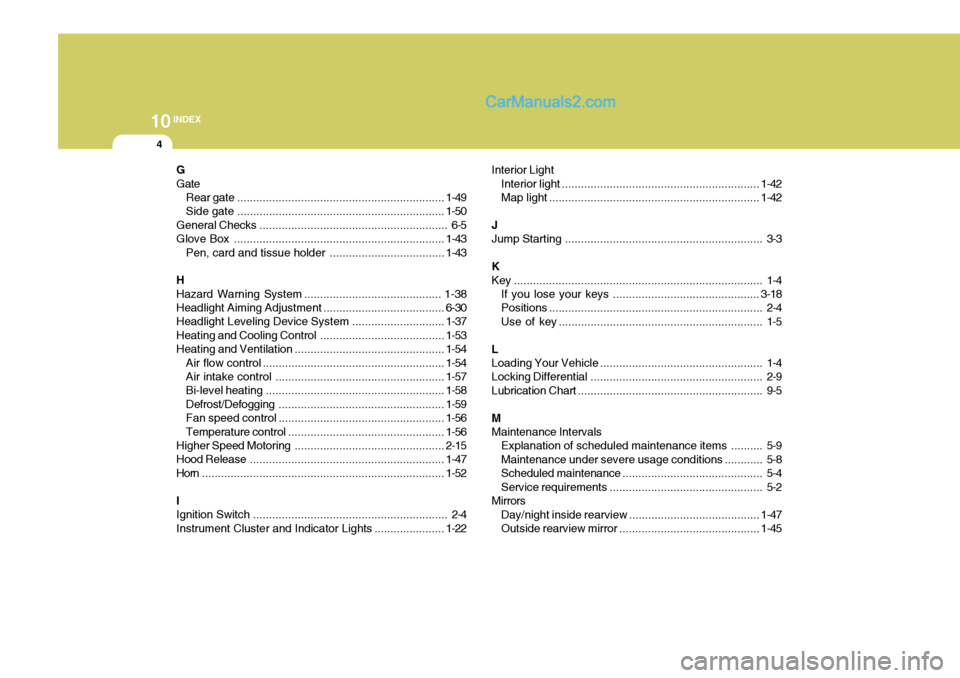2012 Hyundai H-100 Truck service schedule
[x] Cancel search: service schedulePage 108 of 217

2 DRIVING YOUR HYUNDAI
12SMOOTH CORNERING
C150A01A-AAT Avoid braking or gear changing in cor- ners, especially when roads are wet. Ideally, corners should always be taken under gentle acceleration. If you followthese suggestions, tire wear will be held to a minimum.
accumulate on the underside of the car. This extra weight can result inincreased fuel consumption and also contribute to corrosion.
o Travel lightly. Don't carry unneces- sary weight in your car. Weight re-duces fuel economy.
o Don't let the engine idle longer than necessary. If you are waiting (andnot in traffic), turn off your engine and restart only when you're readyto go.
o Remember, your Hyundai does not
require extended warm-up. As soonas the engine is running smoothly, you can drive away. In very cold weather, however, give your enginea slightly longer warm-up period.
o Don't "lug" or "over-rev" the engine.
Lugging is driving too slowly in toohigh a gear resulting in the engine bucking. If this happens, shift to a lower gear. Over-revving is racingthe engine beyond its safe limit. This can be avoided by shifting at the recommended speeds.
o Use your air conditioning sparingly. The air conditioning system is oper-ated by engine power so your fueleconomy is reduced when you use it.
which reduces their effectivenessand may lead to more serious con-sequences.
o Take care of your tires. Keep them
inflated to the recommended pres-sure. Incorrect inflation, either too much or too little, results in unnec- essary tire wear. Check the tire pres-sures at least once a month.
o Be sure that the wheels are aligned
correctly. Improper alignment canresult from hitting curbs or driving too fast over irregular surfaces. Poor alignment causes faster tire wearand may also result in other prob- lems as well as greater fuel con- sumption.
o Keep your car in good condition. For better fuel economy and reducedmaintenance costs, maintain yourcar in accordance with the mainte- nance schedule in Section 5. If you drive your car in severe conditions,more frequent maintenance is re- quired (see Section 5 for details).
o Keep your car clean. For maximum service, your Hyundai should be keptclean and free of corrosive materi- als. It is especially important thatmud, dirt, ice, etc. not be allowed to
Page 109 of 217

2
DRIVING YOUR HYUNDAI
13WINTER DRIVING
chains on the tire will provide a greater driving force, but will not prevent sideskids. NOTE: Tire chains are not legal in all prov- inces. Check province laws beforefitting tire chains. C160C01A-AAT Use High Quality Ethylene Glycol Coolant Your Hyundai is delivered with high quality ethylene glycol coolant in thecooling system. It is the only type of coolant that should be used because it helps prevent corrosion in the coolingsystem, lubricates the water pump and prevents freezing. Be sure to replace or replenish your coolant in accor-dance with the maintenance schedule in Section 5. Before winter, have your coolant tested to assure that its freez-ing point is sufficient for the tempera- tures anticipated during the winter.
C160A01A-AAT The more severe weather conditions of winter result in greater wear and other problems. To minimize the prob- lems of winter driving, you should fol-low these suggestions:
C160B01A-GAT Snowy or Icy Conditions To drive your vehicle in deep snow, it may be necessary to use snow tires orto install tire chains on your tires. If snow tires are needed, it is necessary to select tires equivalent in size andtype to the original equipment tires. Failure to do so may adversely affect the safety and handling of your car.Speeding, rapid acceleration, sudden brake applications, and sharp turns are potentially very hazardous prac-tices. During deceleration, use engine braking to the fullest extent. Sudden brake applications on snowy or icyroads may cause skids to occur. You need to keep sufficient distance be- tween the vehicle in front and yourvehicle. Also, apply the brake gently. It should be noted that installing tire C160D01A-AAT Check Battery and Cables Winter puts additional burdens on the battery system. Visually inspect thebattery and cables as described in Section 6. The level of charge in your battery can be checked by your Hyun-dai dealer or a service station.
C160E01A-AAT Change to "Winter Weight" Oil if Necessary In some climates it is recommended that a lower viscosity "winter weight" oil be used during cold weather. SeeSection 9 for recommendations. If you aren't sure what weight oil you should use, consult your Hyundai dealer.
Page 141 of 217

5VEHICLE MAINTENANCE REQUIREMENTS
2MAINTENANCE INTERVALS
F010C01HR-GAT
Specified Scheduled Procedures
These are the procedures such as
inspections, adjustments and replace- ments that are listed in the mainte-nance charts starting on page 5-4. These procedures must be performed at the intervals shown in the mainte-nance schedule to assure that your warranty remains in effect. Although it is strongly recommended that they beperformed by the factory-trained or distributor-trained technicians at your Hyundai dealer, these procedures maybe performed at any qualified service facility. F010D01A-GAT
General Checks
These are the regular checks you should perform when you drive your Hyundai or you fill the fuel tank. A list of these items will be found on page6-5.
F010A01A-GAT Service Requirements To assure that you receive the great- est number of kilometers of satisfying operation from your Hyundai, certain maintenance procedures must beperformed. Although careful design and engineering have reduced these to a minimum, those that are requiredare of the utmost importance.It is your responsibility to have thesemaintenance procedures performed to comply with the terms of the war- ranties covering your new Hyundai.The Service Passport supplied with your new vehicle provides further in- formation about these warranties.
F010B01A-AAT
Maintenance Requirements
The maintenance required for your
Hyundai can be divided into three main areas:
o Specified scheduled procedures
o General checks
o Do-it-yourself maintenance It is suggested that genuine Hyundai
service parts be used for any requiredrepairs or replacements. Other parts of equivalent quality such as engine oil, engine coolant, manual transmission
oil, brake fluid and so on which are not supplied by Hyundai Motor Company or its distributor may be used withoutaffecting your warranty coverage but you should always be sure these are equivalent to the quality of the originalHyundai parts. Your Service Passport provides further information about your warranty coverage.
Page 142 of 217

5
VEHICLE MAINTENANCE REQUIREMENTS
3SCHEDULED MAINTE- NANCE REQUIREMENTS
F010E01A-AAT
Do-It-Yourself Maintenance
If you are mechanically inclined, own a few tools that are required and want to take the time to do so, you can inspect and service a number of items.For more information about doing it yourself, see Section 6. F010F01A-GAT
A Few Tips
Whenever you have your Hyundai ser- viced, keep copies of the service records in your glove box. This will help ensure that you can document that the required procedures have been performed to keep your warranties ineffect.This is especially important when ser-vice is not performed by an authorizedHyundai dealer. F020A01Y-GAT Inspection should be performed any time a malfunction is experienced or suspected. Receipts for all emissioncontrol system services should be retained to demonstrate compliance with conditions of the emissions sys-tem warranty.For severe usage maintenance re-
quirements, see page 5-8 of this sec-tion.
Page 143 of 217

5VEHICLE MAINTENANCE REQUIREMENTS
4
F030A01HR-GAT
Except European Community
The following maintenance services must be performed to assure good vehicle control and performance. Keep receipts for
all vehicle services to protect your warranty. Where both kilometers and time are shown, the frequency of service is determined by whichever occurs first.
F030D02HR-GAT R : Replace I : Inspect and, after inspection, clean, adjust, repair or replace if necessary SCHEDULED MAINTENANCE
NO. 1 2 3 4 5 6 7 8 9
1011 12 13 DESCRIPTION
ENGINE CONTROL SYSTEM MAINTENANCE (DIESEL)ENGINE OIL AND FILTER AIR CLEANER FILTER FUEL FILTER* VALVE CLEARANCE (For 2.6 N/A, 2.5 TCI) INJECTION TIMING (IF EXHAUST GAS INCLUDES BLACK SMOKE) EGR SYSTEM (VALVE, TUBE, HOSE) TIMING BELT (For 2.6 N/A, 2.5 TCI) DRIVE BELT (FOR WATER PUMP AND ALTERNATOR) ENGINE IDLE SPEED FUEL SYSTEM LEAKS INJECTION NOZZLE (IF EXHAUST GAS INCLUDES BLACK SMOKE) VACUUM PUMP AND VACUUM HOSE VACUUM PUMP OIL HOSE
80 64
I
R I I 90 72
R II I I
70 56
I
6048
R I I I I I I
50 40
I
4032
I I I I
30 24
R II I I
20 16
I I I108
I
See Note(1), (2) See Note(3)
Note : (1) 2.6 N/A, 2.5 TCI : For every 5,000 KM or 6 months, whichever occurs first : "R" A2.5 : For every 10,000 KM or 6 months, whichever occurs first : "R"
(2) Republic of South Africa (If the vehicle is lubricated API CH-4 grade or above.): For every 7,500 KM or 6 months, whichever occurs first : "R"
(3) For China, India and Middle East : For every 15,000 KM or 12 months, whichever occurs first : "R" Except China, India and Middle East : For every 45,000 KM or 36 months, whichever occurs first : "R"
(4) Inspect every day. (5) For every 15,000 KM or 12 months, whichever occurs first : "I"
5 4
See Note(4)
KILOMETERS X 1000 MONTHS
See Note(5)
See Note(5)
Page 215 of 217

10INDEX
4
G GateRear gate ................................................................. 1-49
Side gate ................................................................. 1-50
General Checks ........................................................... 6-5
Glove Box .................................................................. 1-43
Pen, card and tissue holder ....................................1-43
HHazard Warning Syst em ........................................... 1-38
Headlight Aiming Adjustm ent ...................................... 6-30
Headlight Leveling Device S ystem .............................1-37
Heating and Cooling Control .......................................1-53
Heating and Ventilation ............................................... 1-54
Air flow control ......................................................... 1-54
Air intake control ..................................................... 1-57
Bi-level heating ........................................................ 1-58
Defrost/Defogging .................................................... 1-59
Fan speed control .................................................... 1-56
Temperature control ................................................. 1-56
Higher Speed Motoring ............................................... 2-15
Hood Release ............................................................. 1-47
Horn ............................................................................ 1-52
IIgnition Switch ............................................................. 2-4
Instrument Cluster and Indicator Lights ...................... 1-22Interior Light
Interior light .............................................................. 1-42
Map light .................................................................. 1-42
JJump Starting .............................................................. 3-3
K
Key .............................................................................. 1-4 If you lose your keys .............................................. 3-18
Positions ................................................................... 2-4
Use of key ................................................................ 1-5
L Loading Your Vehicle ................................................... 1-4
Locking Differential ...................................................... 2-9
Lubrication Chart .......................................................... 9-5
M Maintenance Intervals Explanation of scheduled maintenance items .......... 5-9Maintenance under severe usage conditions ............ 5-8
Scheduled maintenance ............................................ 5-4
Service requirements ................................................ 5-2
Mirrors Day/night inside rearview .................. .......................1-47
Outside rearview mirror............................................ 1-45